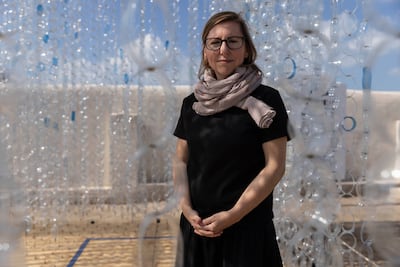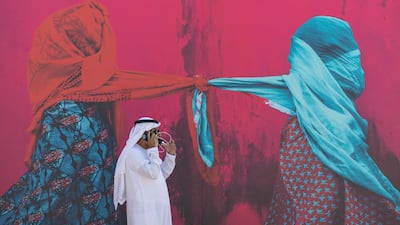Since its inauguration in 2013, Ras Al Khaimah Art has steadily grown to become one of the most unique art festivals in the country.
This year’s outing is arguably the most mature yet. The event is reprising several elements that have made it a family favourite, but it has also honed its curatorial vision with a theme that thoughtfully resonates with its historic venue.
For 2025, Ras Al Khaimah Art is returning to Al Jazeera Al Hamra Heritage Village. The abandoned pearling village, with its coral structures and labyrinthine alleyways, is one of the only of its kind in the UAE, offering insights into the country’s maritime traditions and daily life.

The village was abandoned in the mid 20th century when oil was discovered in the UAE and, at about the same time, artificial pearls were gaining traction in the market, causing the pearling industry to falter rapidly. As many as 2,500 people left and Al Jazeera Al Hamra gained a rather mystical reputation.
As such, the festival’s theme of Memory feels pertinent. About 200 local and international artists have been invited to respond to the equivocal subject. The artworks, which range from photographs to sculptures and installations, are all deeply personal and reflect on the concept of memory in evocative ways.
“The participating artists had to follow the theme,” Alfio Tommasini, the festival’s curator says. “Every artist could interpret freely what a memory is related to their art. The festival’s beginning area is dedicated to childhood, and there are some parts that are more related to archival pictures. Of course, we have so many different works, and we tried to create a narrative between them and the site.”

The artworks have been carefully displayed across the village in a way as to not harm or impede its structures. Some pieces have been mounted on special rails, which are installed a touch away from the coral walls. Others hang from fishing lines. Tommasini says it was a challenge, but one that he eagerly took on.
“I'm used to challenges such as outdoor exhibitions,” he says. “I came in June, when it's very hot, and we started taking measurements. Sometimes we had to make compromises. It was challenging, but it was beautiful.”
Tommasini says he was pleasantly surprised by how some artists reflected on the theme in their works, adding that a few of them responded to the concept of memory indirectly.
German artist Anja Bamberg, for instance, is presenting two works that touch upon how water can be an instrument of memory.

In Tracing liquid memories, the artist is presenting a series of painted wooden panels, which have been developed as a result of spending time in a falaj in Ras Al Khaimah. “I was very lucky to meet a local farm owner, who said I can go to his farm whenever I want,” Bamberg, who is the festival’s artist-in-residence, says. “I really loved it. On some days, they’d switch on the water so I can see how it flows through all these tunnels.” This experience was a pensive one, she says, and inspired the artist to create her piece.
The second is an installation, Suspended Threads, which is on display in the space between two coral houses. The work features 2,000 sliced plastic bottles attached to one another using rivets, and hanging as threads in and around a cubic structure. Visitors are invited to walk within the installation, and hear the plastic pieces tapping against one another with a trickle that sounds deceptively like that of water.

UK artist Spencer Hogg also responded to the theme of memory somewhat indirectly. His series of sculptures, displayed in one of the historic sites, feature found materials, such as sandstone or wood, which have been stacked in ways that beckon our primordial fascination with creating forms and the playful aspect of making art.
“They are all made from locally sourced materials,” he says. “They’re almost monolithic. Something you might find perhaps many years ago, maybe in the Neolithic era. There's that kind of memory within them.”
Several of the pieces exhibited on the outer walls of the village’s structures evidently take their cues from family photographs. Italian artist Debora De Canio’s works is a prime example. One of her photos depicts an old image of her grandmother’s sister, who died at 17 and was photographed only upon her death. The photograph, De Canio says, scared her as a child, and she wanted to recreate the feeling she had when she looked upon it by aesthetically manipulating it. “I scanned the pictures with a scanner and then printed it on acetate paper,” she says.
Local artists, including Ayesha Al Ghafli, are also exhibiting at the festival. Her photograph features a stacked set of VHS cassettes, which her father used to record football games in 2002. The tapes clearly depict dates and the teams playing.
Several artists are also participating with the support of their embassies, including Brazilian artist Rene Machado, who is showcasing his abstract paintings, while Romanian photographer Maria Sturm is presenting photographs with the support of the German embassy. Her works are an exploration and critique of our dependence on cement, a material with dire environmental consequences. Her photographs of microscopic limestone cross-sections also bares the complexities of the material, showing its more vulnerable aspects.

The history of Ras Al Khaimah also has several dedicated exhibitions. Shifting Tides presents Ras Al Khaimah’s landscapes and mangrove forests using virtual reality technology. Memories Between the Lines, meanwhile, showcases archival manuscripts, journals and poetry. The most curious examples show Quranic text that has been printed on Italian paper.
Sheikha Hana bint Juma Al Majid, wife of Sheikh Saud bin Saqr Al Qasimi, Ruler of Ras Al Khaimah, is also participating this year by showcasing photographs she took in Germany in the 1970s, as well as a selection of her own jewellery.
The festival is also reprising family-friendly attractions, with plenty of children’s play areas, as well as a dedicated area for food trucks, such as pop-up Antica Australis. It is run by Australian chef couple Paolo and Kelly Picarazzi, who are known for their fusion of dishes from Paolo’s home of Ciociaria, Italy with seasonal produce. Bringing that approach from Australia to Ras Al Khaimah, they are opting to source their ingredients from the farms of Sheikh Saud bin Saqr.
Ras Al Khaimah Art is running at Al Jazeera Al Hamra Heritage Village from Friday to February 28




